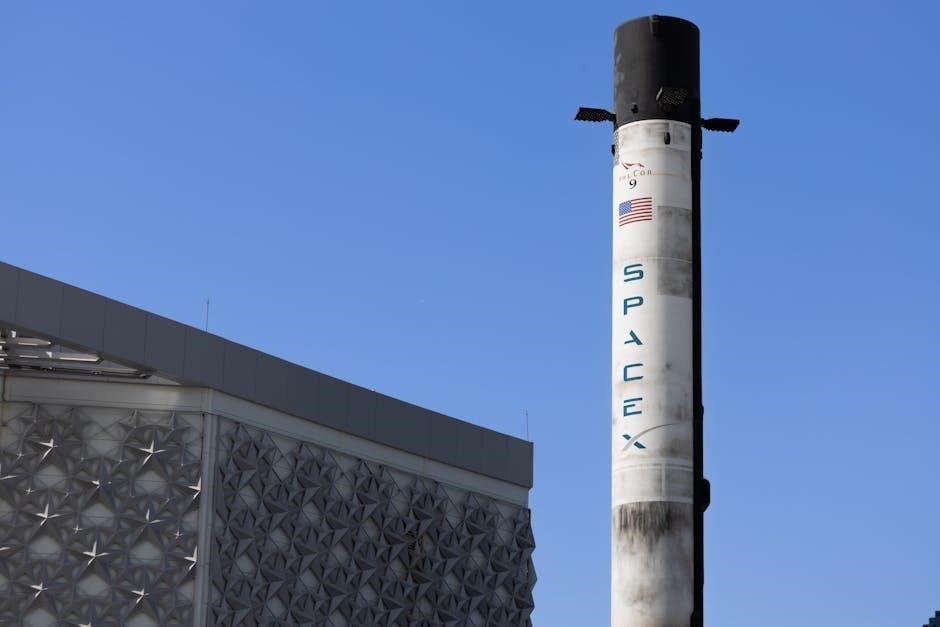Elon Musk’s autobiography offers insights into the life of the visionary entrepreneur, from his challenging South African upbringing to revolutionizing industries like space exploration and electric cars. His journey…

1.1 Overview of Elon Musk’s Life and Achievements

Elon Musk, born on June 28, 1971, in Pretoria, South Africa, is one of the most influential entrepreneurs of the 21st century. His autobiography traces his journey from a challenging childhood to becoming the world’s richest man. Musk’s early interest in technology and physics led him to pursue opportunities in the United States and Canada. He co-founded Zip2 and X.com, which later became PayPal, revolutionizing online payments. In 2002, he founded SpaceX with the ambitious goal of colonizing Mars, and in 2003, he transformed the automotive industry with Tesla, pioneering electric vehicles. His ventures also include SolarCity, Neuralink, and The Boring Company, showcasing his commitment to renewable energy, neurotechnology, and infrastructure innovation. Musk’s autobiography highlights his relentless drive, strategic vision, and the risks he has taken to shape the future of technology and humanity.
1.2 Importance of Reading His Autobiography
Reading Elon Musk’s autobiography is essential for understanding the mindset and strategies of a visionary leader who has reshaped multiple industries. The book offers a detailed account of his challenges, successes, and the risks he has taken to pursue groundbreaking innovations. Through his story, readers gain insights into the intersection of technology, entrepreneurship, and leadership. Musk’s autobiography is not just a personal narrative but also a roadmap for aspiring innovators, highlighting the importance of perseverance and thinking on a global scale. It provides a unique perspective on how he balances ambitious goals, such as Mars colonization and sustainable energy, with the realities of running complex businesses. The autobiography is a valuable resource for anyone interested in the future of technology and the principles that drive one of the world’s most influential figures.

Early Life and Education
Elon Musk was born in Pretoria, South Africa, to Errol and Maye Musk. He developed an early interest in technology, teaching himself programming. After facing bullying, he moved to Canada and later the U.S. for college, studying business and physics.
2;1 Birth and Childhood in South Africa
Elon Musk was born on June 28, 1971, in Pretoria, South Africa, to Errol and Maye Musk. His father was an engineer, and his mother a dietitian. Musk’s childhood was marked by curiosity and a passion for learning. He faced challenges, including bullying at school, which shaped his resilience. His parents encouraged his interest in technology and reading, fostering his early fascination with innovation. Musk’s relationship with his father was strained, describing it as “brutal,” which had a lasting impact on his personality. Despite these difficulties, his upbringing in South Africa laid the groundwork for his future ambitions, driving him to pursue opportunities beyond his homeland.
2.2 Education and Early Interest in Technology

Elon Musk’s fascination with technology began at an early age. He taught himself computer programming and, by 12, created his first software, a space-themed video game called Blastar. Musk attended Pretoria University High School, where he excelled academically despite facing bullying. His intellectual curiosity led him to devour books on physics, mathematics, and engineering. After completing high school, Musk moved to Canada and later the United States to pursue higher education, studying physics and economics at the University of Pennsylvania. His early interest in technology and problem-solving laid the foundation for his future entrepreneurial ventures, including Zip2 and X.com, which showcased his vision for integrating technology into everyday life. Musk’s self-taught skills and academic pursuits created a strong base for his innovative career.
2.3 Move to the United States and Canada
Elon Musk’s journey to North America marked a pivotal shift in his life. He moved to Canada in 1992 to attend college, later transferring to the University of Pennsylvania in the U.S., where he studied physics and economics. This relocation was driven by Musk’s desire to pursue opportunities in a global hub of innovation. His time in Canada and the U.S. exposed him to advanced technological environments and entrepreneurial ecosystems, shaping his future ventures. Musk’s decision to leave South Africa was motivated by his ambition to make a significant impact on the world. This period laid the groundwork for his successful career, as he began exploring ideas that would later lead to companies like Zip2 and X.com. Musk’s transition to the U.S. symbolized his commitment to innovation and his vision for a transformative future.

Career Highlights
Elon Musk’s career spans founding Zip2, X.com, SpaceX, Tesla, SolarCity, Neuralink, and The Boring Company, revolutionizing industries like technology, space exploration, automotive, and renewable energy through innovative ventures and vision.
3.1 Founding of Zip2 and X.com
Elon Musk’s entrepreneurial journey began with Zip2, an online city guide he co-founded in 1996 with his brother Kimbal. The company provided local business directories and maps, quickly gaining traction. In 1999, Zip2 was sold to Compaq for over $300 million, marking Musk’s first major success. Shortly after, he co-founded X.com in 1999, an online payment system that later evolved into PayPal. PayPal’s innovative approach to digital payments led to its acquisition by eBay in 2002 for $1.5 billion. These early ventures showcased Musk’s ability to identify market needs and build transformative businesses, setting the stage for his future endeavors in technology and space exploration.
3.2 Role in PayPal and Its Sale
Elon Musk played a pivotal role in the creation and success of PayPal, an online payment system born out of X.com. As a co-founder, he helped shape the company’s vision of enabling secure digital payments. His leadership and innovative thinking were instrumental in positioning PayPal as a leader in the emerging digital payment industry. However, Musk’s tenure was not without challenges, including conflicts with other executives over the company’s direction. Despite these hurdles, PayPal’s success culminated in its acquisition by eBay in 2002 for $1.5 billion. Musk’s share of the sale netted him approximately $165 million, providing the capital he needed to pursue future ventures like Tesla and SpaceX. His time at PayPal showcased his ability to revolutionize industries and navigate complex business landscapes, solidifying his reputation as a visionary entrepreneur.
3.3 Founding of SpaceX and Its Ambitions
Elon Musk founded SpaceX in 2002 with the ambitious goal of reducing space transportation costs and enabling the colonization of Mars. This vision stemmed from his desire to ensure humanity’s survival as a multi-planetary species. Musk’s leadership at SpaceX led to groundbreaking achievements, including the development of the Falcon rocket family and the Dragon spacecraft. In 2008, SpaceX became the first privately funded company to launch a liquid-fueled rocket, the Falcon 1, into orbit. Later, the Falcon 9 and Falcon Heavy rockets demonstrated reusable technology, significantly lowering the cost of access to space. The Dragon spacecraft successfully docked with the International Space Station in 2012, marking a historic milestone. SpaceX’s long-term ambitions include establishing a permanent human presence on Mars through the Starship program. Musk’s relentless pursuit of innovation and his willingness to take risks have positioned SpaceX as a pioneer in the space industry, reshaping humanity’s future in space exploration.
3.4 Transformation of the Automotive Industry with Tesla
Elon Musk revolutionized the automotive industry through Tesla, Inc., which he co-founded in 2003. Tesla’s mission was to accelerate the world’s transition to sustainable energy by making electric vehicles (EVs) desirable and accessible. The company’s first car, the Tesla Roadster, launched in 2008, showcased the potential of electric vehicles, combining high performance with environmental sustainability. The Model S, introduced in 2012, further transformed perceptions of EVs, offering luxury, range, and advanced technology. The Model 3, launched in 2017, became one of the best-selling electric vehicles globally, making EVs more affordable for the mass market; Tesla’s innovative approach, including software updates and autonomous driving features, has set new industry standards. The company’s success has spurred traditional automakers to invest heavily in EV technology, accelerating the global shift toward electrification. Through Tesla, Musk has not only transformed the automotive industry but also played a pivotal role in advancing sustainable energy solutions worldwide.
3.5 SolarCity and Renewable Energy Initiatives
SolarCity, co-founded by Elon Musk in 2006, played a pivotal role in advancing renewable energy solutions. The company aimed to make solar power more accessible and affordable for homeowners and businesses. SolarCity’s innovative approach included solar leasing models, which reduced upfront costs for consumers, and the development of the Powerwall battery, enabling energy storage for solar-powered homes. Musk’s vision was to integrate solar energy with Tesla’s electric vehicles, creating a sustainable ecosystem. In 2016, Tesla acquired SolarCity, further solidifying its commitment to clean energy. The merger allowed for the development of products like the Solar Roof, combining solar panels with roofing materials. Through SolarCity, Musk demonstrated his dedication to accelerating the world’s transition to renewable energy, aligning with his broader goals of combating climate change and promoting sustainability.
3.6 Neuralink and The Boring Company
Neuralink, founded by Elon Musk in 2016, focuses on developing brain-machine interfaces (BMIs) to integrate the human brain with artificial intelligence. The company aims to create implantable chips that could treat medical conditions like paralysis and ultimately enhance human cognition. Musk envisions a future where humans can seamlessly communicate with computers, preventing AI from surpassing human intelligence. Meanwhile, The Boring Company, established in 2016, seeks to revolutionize transportation by building underground tunnels to reduce traffic congestion. The company has developed advanced drilling technology and tested projects like the Loop system in Las Vegas. Both ventures highlight Musk’s commitment to solving complex challenges, from health and transportation to the future of humanity.

Personal Life and Family
Elon Musk’s complex family dynamics, including his challenging relationship with his father Errol and his multiple marriages, highlight his personal struggles and unique approach to family life and privacy.
4.1 Family Background and Parents
Elon Musk was born to Errol and Maye Musk in Pretoria, South Africa. His father, Errol, was an engineer and pilot, while his mother, Maye, was a dietitian and model. Musk’s relationship with his father was strained, often described as abusive and controlling. Errol’s strict nature and high expectations deeply impacted Elon’s childhood, fostering both resilience and a drive to escape his difficult home environment. Despite the challenges, Musk’s parents instilled in him a strong work ethic and intellectual curiosity. His father’s engineering background likely influenced Elon’s early interest in technology, though their relationship remained fraught with tension. Maye, on the other hand, provided emotional support and encouraged Elon’s ambitions. The family dynamics, including his siblings, shaped Musk’s personality and laid the foundation for his future achievements, blending both struggle and inspiration.
4.2 Marriages and Children
Elon Musk’s personal life has been marked by multiple marriages and a growing family. He first married Justine Wilson, a Canadian author, with whom he had six children, including twins Griffin and Xavier, and triplets Damian, Saxon, and Kai. The couple divorced in 2008. Musk then married British actress Talulah Riley in 2010, and they divorced in 2012, remarried in 2013, and divorced again in 2016. In 2018, Musk began a relationship with musician Grimes (Claire Boucher), with whom he had two children: X Æ A-Xii (later renamed X AE A-Xii) and Techno Mechanicus, born via surrogacy. Musk also has a daughter with Grimes, named Exa Dark Sideræl, conceived through IVF. His autobiography provides insights into his complex family life, balancing parenthood with his demanding career, and his unconventional approach to raising his children, often reflecting his futuristic vision and personal values.
4.3 Public Image and Personality Traits
Elon Musk’s public image is a blend of visionary genius and polarizing figure. Known for his ambitious goals and relentless work ethic, he is often portrayed as a modern-day Edison or da Vinci. His charismatic yet introverted personality has captivated global audiences, making him a household name. Musk’s ability to inspire loyalty in his followers and criticism from his detractors underscores his complex character. His autobiography reveals a man driven by a deep sense of purpose, often prioritizing his vision for humanity’s future over personal relationships or public perception. Critics describe him as ruthless in business, while admirers praise his unwavering commitment to innovation. Musk’s sense of humor and unfiltered tweets further humanize him, showcasing a leader who is both brilliant and flawed. His autobiography offers a candid look at the traits that have shaped his legacy, blending introspection with unapologetic ambition.

Challenges and Controversies
Elon Musk’s autobiography reveals his resilience amid personal and professional challenges, including childhood struggles, leadership criticism, and controversies like his tweet about taking Tesla private, showcasing his complex journey.
5.1 Business Challenges and Failures
Elon Musk’s autobiography delves into his significant business challenges, including the rocky production of Tesla’s Model 3, which strained the company’s finances and reputation. SpaceX faced setbacks with rocket explosions, delaying key missions. Musk’s leadership style and demanding work culture at Tesla drew criticism, leading to high turnover. Additionally, SolarCity’s financial struggles and its acquisition by Tesla sparked shareholder lawsuits. These failures, while damaging, showcased Musk’s resilience and ability to adapt under pressure. His autobiography highlights how these challenges shaped his strategic decisions and reinforced his determination to pursue ambitious goals despite adversity. The book provides a candid look at the risks and setbacks that have defined Musk’s entrepreneurial journey, offering valuable insights into the high-stakes world of innovation and leadership.
5.2 Personal Controversies and Criticisms

Elon Musk’s autobiography sheds light on his personal controversies, including his complex family dynamics and public feuds. His relationship with his father, Errol Musk, is described as abusive and controlling, leaving lasting emotional scars. Additionally, Musk has faced criticism for his unpredictable behavior on social media, such as controversial tweets that have sparked debates and legal issues. His high-profile relationships and unconventional parenting choices, including the naming of his children, have also drawn public scrutiny. Furthermore, allegations of a toxic work culture at his companies have raised questions about his leadership style. These controversies highlight the challenges Musk has faced in balancing his personal life with his professional ambitions, often leading to public backlash and intense media attention. His autobiography provides a introspective look at how these personal struggles have shaped his identity and public perception.
5.3 Leadership Style and Work Culture
Elon Musk’s autobiography reveals his demanding leadership style, which has been both praised and criticized. Known for his visionary ideas, Musk pushes his teams to achieve groundbreaking innovations, often under tight deadlines. His hands-on approach and high expectations have driven companies like SpaceX and Tesla to remarkable successes. However, this has also led to criticism about the intense work culture at his firms, with reports of burnout and long working hours. Musk’s tendency to micromanage and set unrealistic targets has sparked debates about his management practices. Despite these criticisms, his ability to inspire and motivate teams to pursue ambitious goals remains unparalleled. The autobiography offers a candid look at how Musk’s leadership style has shaped his companies and the broader tech industry, highlighting both the brilliance and the challenges of working under his direction.

Legacy and Impact
Elon Musk’s autobiography underscores his transformative impact on technology, space exploration, and sustainability. His visionary ideas have reshaped industries, inspiring future generations to pursue bold innovation and rethink the possibilities of tomorrow.
6.1 Contributions to Technology and Innovation
Elon Musk’s autobiography highlights his groundbreaking contributions to technology and innovation. As the founder of SpaceX, he pioneered reusable rockets, significantly reducing space exploration costs. With Tesla, he revolutionized the automotive industry by popularizing electric vehicles and advancing battery technology. Additionally, Musk’s ventures like Neuralink and The Boring Company explore futuristic concepts such as brain-machine interfaces and high-speed transportation solutions. His work at SolarCity pushed renewable energy adoption, while X.com laid the groundwork for modern online payments through PayPal. Musk’s autobiography serves as a roadmap of strategic decisions and calculated risks, showcasing how he transformed industries and inspired a new generation of innovators. His relentless pursuit of innovation has left an indelible mark on technology, making his story a testament to visionary leadership and the power of bold ideas.
6.2 Vision for the Future and Mars Colonization
Elon Musk’s autobiography delves into his extraordinary vision for the future, particularly his ambitious goal of making humanity a multi-planetary species. Through SpaceX, Musk aims to establish a permanent human settlement on Mars, ensuring the survival of humanity even if Earth faces catastrophic events. His Starship program represents a significant step toward this vision, with reusable rockets designed to transport both people and cargo to the Red Planet. Musk’s autobiography reveals his unwavering belief in the importance of becoming a space-faring civilization and his relentless pursuit of innovation to achieve this. By sharing his strategic decisions and challenges, the autobiography provides insight into how Musk intends to revolutionize space travel and pave the way for a future where Mars is not just a destination but a new home for humanity.
6.3 The Significance of His Autobiography
Elon Musk’s autobiography holds immense significance as it provides a detailed and intimate look into the life of one of the most influential figures of our time. The book serves as a roadmap for aspiring entrepreneurs and innovators, offering insights into Musk’s strategic decisions and the risks he undertook to shape industries. By chronicling his journey from a challenging childhood in South Africa to becoming the world’s richest man, the autobiography inspires readers to think ambitiously and pursue groundbreaking ideas. It also highlights Musk’s vision for humanity’s future, including his efforts to revolutionize space travel and sustainable energy. The autobiography is not just a personal story but a testament to innovation, resilience, and the power of vision. Through its pages, readers gain a deeper understanding of Musk’s impact on the world and the principles that drive his relentless pursuit of progress.

